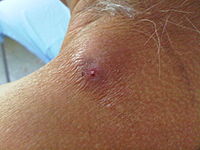
Photo from wikipedia
BACKGROUND Myiasis complication of diabetic foot ulcer has only been presented in a few case reports. Therefore, there is a need for additional data on this infestation. OBJECTIVE Evaluate clinical… Click to show full abstract
BACKGROUND Myiasis complication of diabetic foot ulcer has only been presented in a few case reports. Therefore, there is a need for additional data on this infestation. OBJECTIVE Evaluate clinical characteristics of human myiasis in patients with diabetic foot. DESIGN Case series. SETTINGS A tertiary referral healthcare institution and a diabetic foot center. PATIENTS AND METHODS Patients with diabetic foot infection complicated by myiasis who were admitted between June 2012 and July 2017. MAIN OUTCOME MEASURES Bacterial infection rate, accompanying bacterial agents, amputation (morbidity) and mortality rate. SAMPLE SIZE 18. RESULTS Eight (44.4%) of the patients were female. Sixteen (88.9%) had moderate-to-severe infections; 15 (83.3%) had necrotic tissue. Larval debridement therapy was performed on all patients at the bedside in consecutive sessions. A third-stage larva of Calliphora was detected in one case (5.6%). Second- and third-stage larvae of Lucilia sericata were detected in 5 (27.8%) and 7 (38.9%) patients, respectively. All the patients had a bacterial infection with myiasis. Twelve (66.7%) patients underwent amputation. Three (16.7%) patients died. Myiasis was more frequent in the months of May, June and July. CONCLUSION To our knowledge, this is the largest reported series of cases of diabetic foot with myiasis. The most common parasitic agent was Lucilia sericata. Bacterial soft tissue infections were observed in all cases. Poor hygienic conditions were noteworthy and all patients were in need of radical surgery. Myiasis complication of diabetic foot is more frequently seen in the spring and summer. LIMITATIONS Insufficient follow-up time for analysis of possible confounding factors.
Journal Title: Annals of Saudi Medicine
Year Published: 2018
Link to full text (if available)
Share on Social Media: Sign Up to like & get
recommendations!